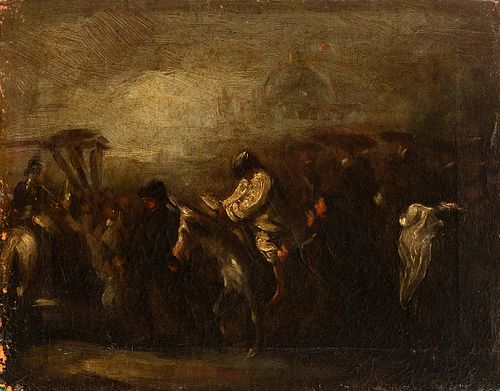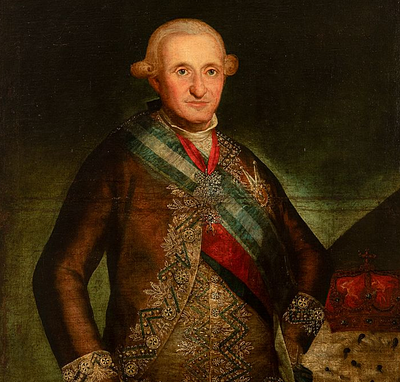Attribution to EUGENIO LUCAS VELAZQUEZ (Madrid, 1817-1870) "Condemned by the Inquisition". Oil on canvas.
Lot 40
About Seller
Setdart Auction House
Carrer Aragó 346
Barcelona
Spain
Setdart Subastas was born in 2004 and is currently the first online art auction in Spain with solidity, prestige and reliability guaranteed by our more than 60,000 users. Setdart has a young, dynamic and enterprising team ready to successfully manage the purchase and sale of art works through custom...Read more
Estimate:
EUR€2,500 - EUR€3,000
$2,688.17 - $3,225.81
Absentee vs Live bid
Two ways to bid:
- Leave a max absentee bid and the platform will bid on your behalf up to your maximum bid during the live auction.
- Bid live during the auction and your bids will be submitted real-time to the auctioneer.
Bid Increments
| Price | Bid Increment |
|---|---|
| EUR€0 | EUR€10 |
| EUR€200 | EUR€25 |
| EUR€500 | EUR€50 |
| EUR€1,000 | EUR€100 |
| EUR€3,000 | EUR€200 |
| EUR€5,000 | EUR€500 |
| EUR€10,000 | EUR€1,000 |
| EUR€20,000 | EUR€2,000 |
| EUR€50,000 | EUR€5,000 |
About Auction
By Setdart Auction House
Sep 22, 2021
Set Reminder
2021-09-22 09:30:00
2021-09-22 09:30:00
America/New_York
Bidsquare
Bidsquare : 22nd September - ARAS JÁUREGUI Private Collection - Old Masters, 19th & 20th Century
https://www.bidsquare.com/auctions/setdart-auction-house/22nd-september---aras-j-uregui-private-collection---old-masters-19th-20th-century-7427
ARAS JÁUREGUI Private Collection - Old Masters, 19th & 20th Century Setdart Auction House sofia@setdart.com
ARAS JÁUREGUI Private Collection - Old Masters, 19th & 20th Century Setdart Auction House sofia@setdart.com
- Lot Description
Attribution to EUGENIO LUCAS VELAZQUEZ (Madrid, 1817-1870) "Condemned by the Inquisition". Oil on canvas. It presents faults and holes. Measurements: 28,5 x 36 cm. The court of the Holy Office, known as the Inquisition was abolished in 1834, by decree of the queen María Cristina de Borbón (1806-1878). Therefore, Eugenio Lucas Velázquez was not a first-hand witness to the practices of this institution. However, Lucas Velázquez's interest in the figure of Goya led him to develop the imagery of the master of Fuendetodos. For this reason he interpreted the scenes in which Goya fiercely criticised society, such as the works dealing with the Inquisition. He brought a more sumptuous, suggestive and, to a certain extent, picturesque aesthetic. Thus creating an aesthetic close to the precepts of Romanticism, typical of the society of the time. For this reason, in this dramatic scene, we can appreciate the loose, unrestrained brushstrokes, with the dark tones characteristic of Lucas Velázquez's painting and Goya's heirs. Lucas Velázquez is undoubtedly the Spanish Romantic artist who best understood Goya's art, becoming the most important and passionate follower of the Goyaesque universe after the death of the Aragonese genius, whose essence he managed to assimilate to the point of sometimes making it difficult to correctly attribute certain little-studied works. Mentioned since the 19th century as Eugenio Lucas Padilla or Eugenio Lucas the Elder and as a native of Alcalá de Henares, he was actually born in Madrid on 9 February 1817. He began his artistic training as a pupil at the San Fernando Academy, although, dissatisfied with the cold classicism of academic teaching, he preferred to study the great geniuses of Spanish painting directly and at the Prado Museum he copied Velázquez and, above all, Goya, whose work would definitively mark the style and creative personality of this artist. Lucas found in Goya's compositions an extraordinary vein in which to develop imaginative painting of unleashed passions, fantastic visions and scenes of intense drama in the most genuine Romantic spirit, chiefly scenes of the Inquisition, witchcraft, witchcraft, pilgrimages, manolas and bulls, all themes he had learned from Goya and which constitute the most interesting core of his extremely prolific artistic career. In 1850 he also painted the ceiling of the Teatro Real in Madrid, which has now disappeared, and later Queen Isabella II appointed him honorary chamber painter and knight of the order of Charles III.
- Shipping Info
-
In-house shipping available. Please inquire at admin@setdart.com.
-
- Buyer's Premium



 EUR
EUR CAD
CAD AUD
AUD GBP
GBP MXN
MXN HKD
HKD CNY
CNY MYR
MYR SEK
SEK SGD
SGD CHF
CHF THB
THB















